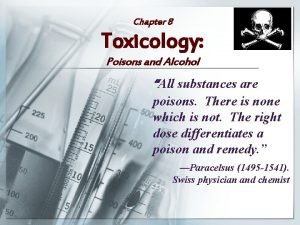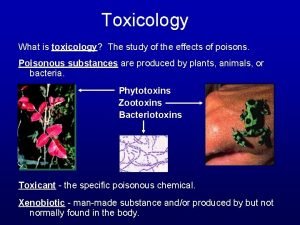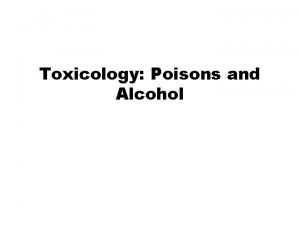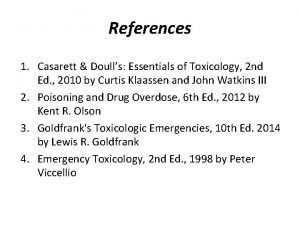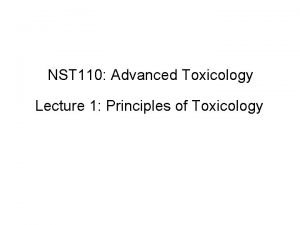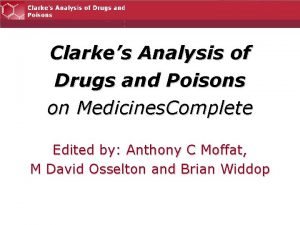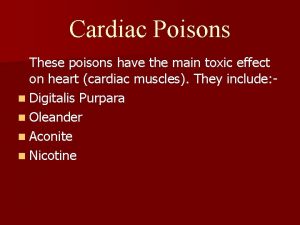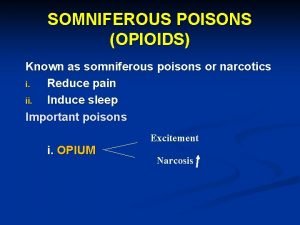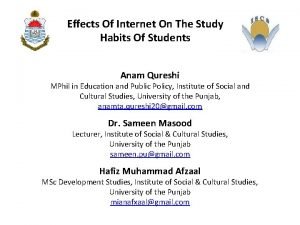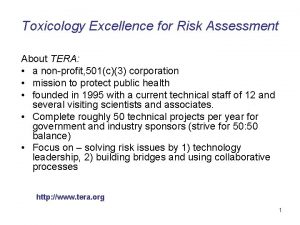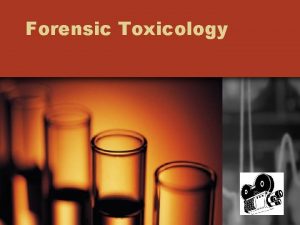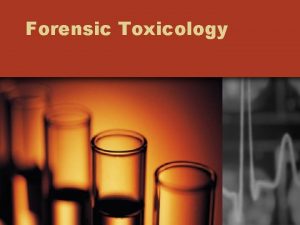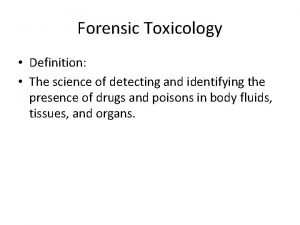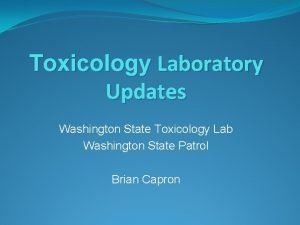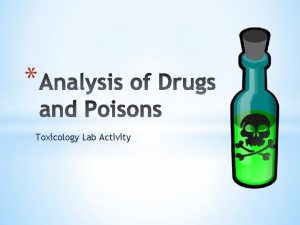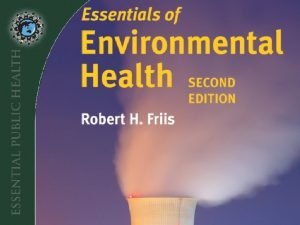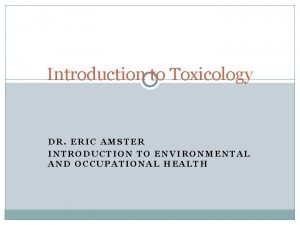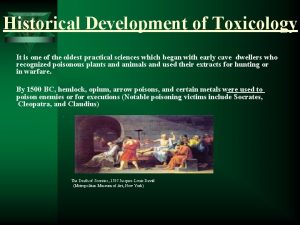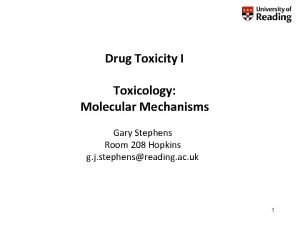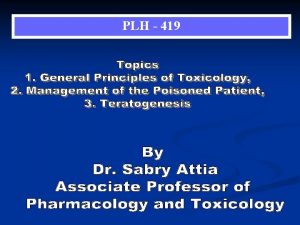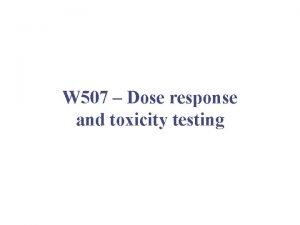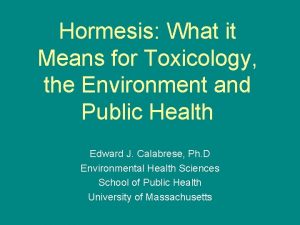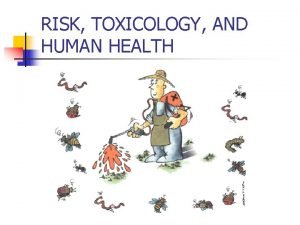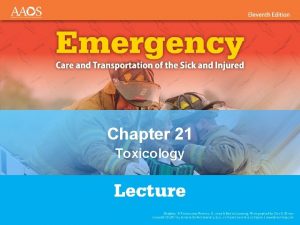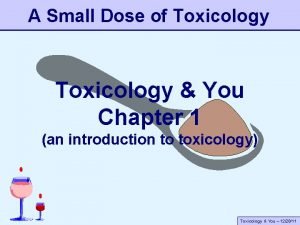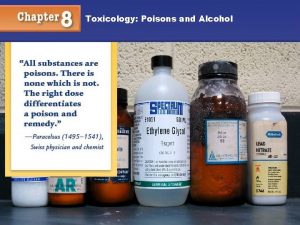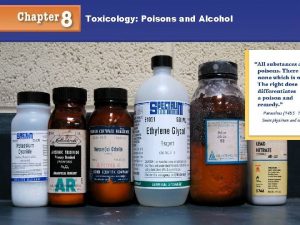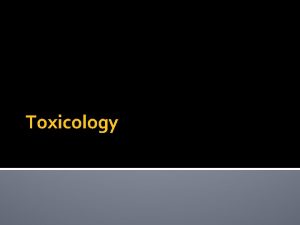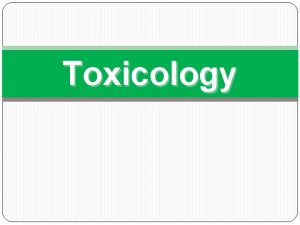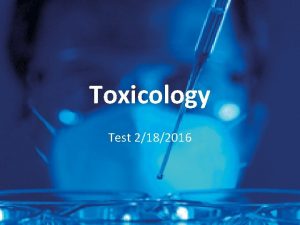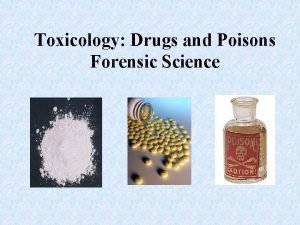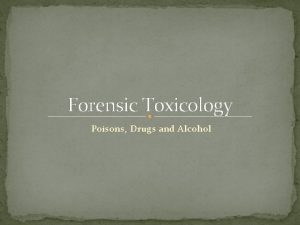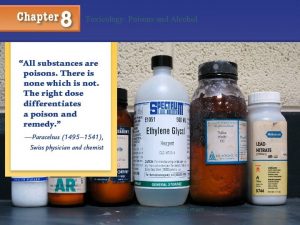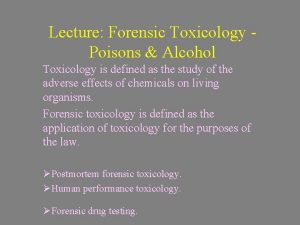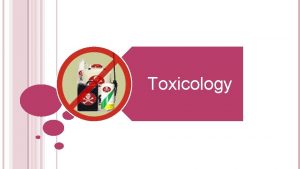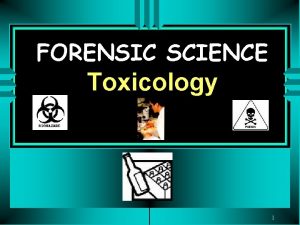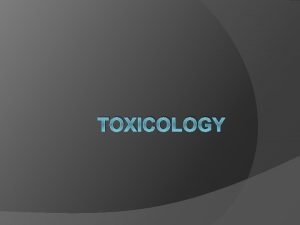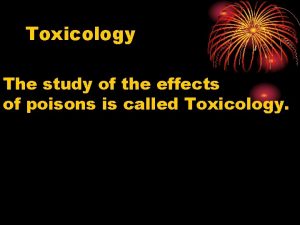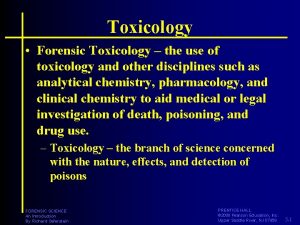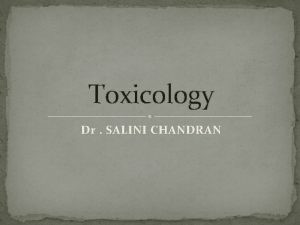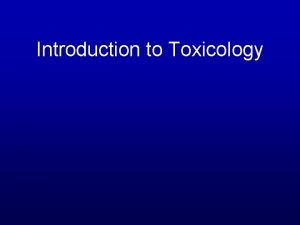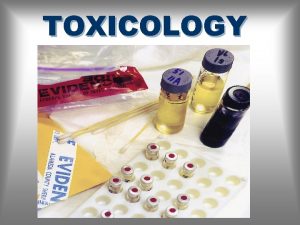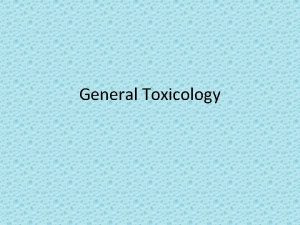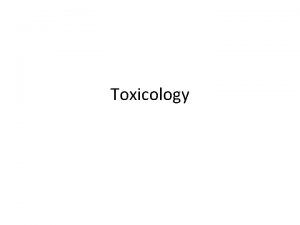Toxicology The study of poisons and their effects




















































- Slides: 52

Toxicology The study of poisons and their effects, on living systems

Love Canal Cleanup Finished, Mutants Return to Homes We knew there were too many miscarriages, too many birth defects, too many central nervous system problems, too many urinary tract disorders, and too much asthma and other respiratory problems among us. "

Health: A state of complete physical, mental, and social well-being n Disease: A deleterious change in the body’s condition in response to an environmental factor that could be nutritional, chemical, biological, or psychological n Morbidity: Illness n

Types of Environmental Health Hazards Infectious Diseases n Toxic Chemicals n Natural or Synthetic Toxins n Physical Agents, Trauma and Stress n Diet n

Pathogens are infectious organisms Bacterial n Protozoans (guardia) n Fungal n Invertebrate Animals n Viruses are non living n


Bacterial Infections: Trachoma is an inflammation of eye Sexual Transmitted Diseases (gonorrhea and syphilis) Respiratory Diseases: Pneumonia, tuberculosis, influenza, and pertussis

Bacteria have developed resistance to antibiotics Improved drugs and sanitation can eliminate some diseases

Trachoma, the most commonly contracted STD, caused by Chlamydia trachomatis

Emergent diseases n Those not previously known or that have been absent for more than 20 year *many are viruses

Viral Infection SARS and Bird flu n HANTA, Ebola n West Nile virus causes encephalitis n HIV and AIDS n

Fungal Sudden oak death n Fungal spores *black mold n

Protozoans Malaria: Infection of red blood cells by the protozoan Plasmodium spread by the Anopheles mosquito n Giardia: dysentery n Amoeba: dysentery n

Invertebrate Animals (Parasitic) Flatworms (flukes) and tapeworms n Nematodes (roundworms) n – – – such as hookworms, guinea worms Filariasis worms block lymphatic vessels causes elephantiasis


Caused by Nematodes (Roundworms) Elephantiasis Filariasis Guinea worms

prions n Proteins resistant to temperature. They cause Chronic Wasting in Wild Animals and Mad Cow Disease also known as Creutzfelt. Jacop disease

Toxic Chemicals Hazardous: Dangerous n Toxic: Poisonous n Irritants: Corrosives (acid), caustics (base), and other substances that damage biological tissues n Respiratory Fibrotic Agents: Irritants that damage the lungs n

n Asphyxiants: Chemicals that exclude oxygen or actively interfere with oxygen uptake and distribution (i. e. MIC)

n. Allergens: Substances that activate the immune system. Some act as Antigens which are recognized as foreign by white blood cells. Antigens cause the immune system to produce Antibodies.

Mutagen: with change the base sequence in DNA, may be harmless or harmful. n n Cancer: Invasive, out-of-control cell growth that results in malignant tumors Carcinogens: Substances that cause cancer Promoter: Bases sequences in DNA that regulate expression of that gene Terratogens: discussed further

Mutagens: Agents that damage or alter DNA n Teratogens: Factors that cause abnormalities during embryonic growth and development (example: thalidomide) – – Fetal Alcohol Syndrome: Symptoms including craniofacial abnormalities, developmental delays, behavioral problems, and mental defects. Thalidamine: used to prevent morning sickness and in treatment of leprosy.

Thalidomide for morning sickness

Carcinogens aflatoxin acrylamide

Francis Oldem Kelsey Prevent FDA from approving Prevented 1000 birth defects in USA Awarded President’s Award for Distinguished Federal Civilian Service

Endocrine Disrupters n Neurotoxins: Attack nerve cells n – – – Heavy metals (mercury, lead) Chloronated hydrocarbons (DDT, dioxin) disrupt nerve cell membranes Organophosphates (pesticides

organophosphates mercury

How Do Environmental Toxins Enter Our Bodies? introduced into our lives everyday n depend on where we live n They are in the air you breath, the food you eat, water, buildings, pesticides, and consumer products. n They are the byproducts of industry n

Basic Concepts n n Def: science that studies poisons or toxics Pathways from environment -> us – – – oral ingestion inhalation percutaneous absorption (skin)

n 17. 8% of California’s lakes are under fish consumption advisories due to mercury, dioxins and other Persistent Bioaccumulative Toxins!!!

n The average household uses and stores more than 60 hazardous materials, including household cleaners, automotive products, paints, solvents and pesticides

Household sources of Toxic Chemicals Off the shelf pesticides, herbicides, fungicides and insecticides n Paints and paint cleaning supplies n Household cleaning solutions, laundry detergents with phosphates n Bleached paper products n

n Over 150 chemicals found in the average home have been linked to allergies, birth defects, cancer and psychological abnormalities Consumer Product Safety Commission www. earthwellness. com

Some of the biggies Dioxin is an unintentional bi-product of industrial processes using chlorine. It includes more than 200 chemicals. n PVC, Polyvinyl Chloride, is the most widely used plastic n

Physical Agents, Trauma, and Stress Trauma: Injury caused by accidents or violence n Stress: Physical, chemical, or emotional factors that place a strain on an organism for which there is inadequate adaptation n

Movement, Distribution and Fate of the Toxin Solubility water vs fat soluble n Bioaccumulation and Biomagnification n Persistence n Chemical Interaction n

Bioaccumulation and Biomagnification Bioaccumulation: The ability of cells to absorb and store of a select molecules When is this beneficial vs detrimental? n Biomagnification: the toxin level accumulates in those organisms higher up in the food chain. i. e. DDT n


Chemical Interactions n Antagonistic: One chemical counteracts the effects of another – n Vitamins A, C, and E reduce response of some carcinogens Additive and Synergistic: : two chemical that occur together exacerbates the effects of another

How Do We Measure Toxicity Animal testing n Toxicity ratings n Acute verses chronic doses and effects n Detection limits n

Animal Testing n LD 50: The dose of a toxic chemical to which 50% of the test population is sensitive 9. 11, 9. 12



Acute vs Chronic Doses and Effects Acute Effects: Effects causes by a single exposure to the toxin resulting in an immediate health crisis n Chronic Effects: Long lasting or permanent effects n Exposures: If long lasting can be chronic 9. 13 n

Fig 8. 17

Risk: The probability of harm times the probability of exposure Assessment & Management High Risk: Habitat destruction, loss of biodiversity Medium Risk: Toxins Low Risk Oil Spills, Radionuclides n

What happened in Bhopal, India?

Methylisocyanate An irritant, causes burning and swelling of soft tissue n The lack of oxygen lead to death n Blindness to the survivors n

What happened in Chernobyle

How Can We Reduce Our Risk of Exposure to Environmental Toxins?

Increase your awareness pass that knowledge on to friends and family Limit your exposure to toxic chemicals by knowing what is in the products you buy for yourself and family. Use minimal amounts of organic pesticides and fertilizers and encourage your neighbors to do the same Express your views to and make demands on your local representatives, school board, federal agencies

n Change your lifestyle by minimizing your use and exposure to toxic substances! Encourage those around you to change theirs n n n Buy organic fruits and vegetables, meats, and dairy products as much as possible. Limit your use of products (toilet paper, tampons, and other paper products) which have been through a chlorine process to whiten the product. Limit your exposure to plastic products. Use minimal amounts of organic pesticides and fertilizers and encourage your neighbors to do the same.
 Chapter 8 toxicology poisons and alcohol
Chapter 8 toxicology poisons and alcohol Toxicology types
Toxicology types What is toxicology?
What is toxicology? Toxicology effects
Toxicology effects Toxicology effects
Toxicology effects Ld50 examples
Ld50 examples Clarke's analysis of drugs and poisons
Clarke's analysis of drugs and poisons Mitha bish
Mitha bish Somniferous poisons
Somniferous poisons Erythism
Erythism Language features and their effects
Language features and their effects Language features and their effects
Language features and their effects Toxicology and applied pharmacology
Toxicology and applied pharmacology Annual review of pharmacology and toxicology
Annual review of pharmacology and toxicology Food safety and toxicology
Food safety and toxicology Drug identification and toxicology
Drug identification and toxicology Effects of internet use and study habits
Effects of internet use and study habits Toxicology excellence for risk assessment
Toxicology excellence for risk assessment Important dates in forensic science
Important dates in forensic science Forensic toxicologist definition
Forensic toxicologist definition Forensic toxicologist definition
Forensic toxicologist definition Forensic toxicologist definition
Forensic toxicologist definition Define environmental toxicology
Define environmental toxicology Toxicology management
Toxicology management Washington state patrol toxicology lab
Washington state patrol toxicology lab Forensic toxicology lab activity
Forensic toxicology lab activity Toxicology definition
Toxicology definition Nc medical examiner and coroner guidelines
Nc medical examiner and coroner guidelines Toxicology
Toxicology Examples of toxicology
Examples of toxicology Toxicology
Toxicology Toxicology
Toxicology Toxicology defination
Toxicology defination Toxicology
Toxicology Importance of toxicology
Importance of toxicology Hormesis definition
Hormesis definition Forensic toxicology vocabulary
Forensic toxicology vocabulary Chapter 21 toxicology
Chapter 21 toxicology A small dose of toxicology
A small dose of toxicology Romeo and juliet chorus translation
Romeo and juliet chorus translation Hình ảnh bộ gõ cơ thể búng tay
Hình ảnh bộ gõ cơ thể búng tay Slidetodoc
Slidetodoc Bổ thể
Bổ thể Tỉ lệ cơ thể trẻ em
Tỉ lệ cơ thể trẻ em Gấu đi như thế nào
Gấu đi như thế nào Tư thế worm breton
Tư thế worm breton Alleluia hat len nguoi oi
Alleluia hat len nguoi oi Các môn thể thao bắt đầu bằng từ đua
Các môn thể thao bắt đầu bằng từ đua Thế nào là hệ số cao nhất
Thế nào là hệ số cao nhất Các châu lục và đại dương trên thế giới
Các châu lục và đại dương trên thế giới Công của trọng lực
Công của trọng lực Trời xanh đây là của chúng ta thể thơ
Trời xanh đây là của chúng ta thể thơ Cách giải mật thư tọa độ
Cách giải mật thư tọa độ
